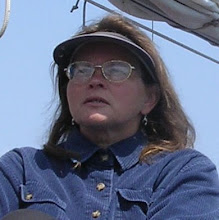One of the propelling causes of building Swallowtail (or Swallow Tail as it was called in the 1850s) lighthouse was the wreck of the Lord Ashburton on January 19, 1857 and the death of 28 crew men. The Lord Ashburton floundered on the northern shore of Grand Manan after struggling to get to the port of Saint John from Toulon, France, loosing its anchorage and being driven back in a nor'easter to the rocky shores of Grand Manan. One man, James Lawson, climbed the rocky headland, now names Ashburton Head, in his bare feet and walked until he found a barn where he collapsed. He was found and related the tragedy. Seven others were found alive but died shortly afterwards. If anyone know this area it was quite the feat to scale those cliffs.
The need for a light house had been discussed in the New Brunswick Assembly as early as 1840 but it took the Lord Ashburton tragedy to finally have the lighthouse built.
Construction of the light tower and keepers house began in the summer of 1859 after purchasing the land from James Small. Because the lantern had to be shipped from England, it took until the next year to arrive and be installed.
Winter storms are a part of life along our shores with a mix of snow and rain commonplace. Our streets are a glace of ice at the moment from a snow storm that turned to rain and then the temperature plummeted. The Bay of Fundy moderates the air temperature, often giving Grand Manan the warmest temperatures in the province in the winter (and some of the coldest in the summer). We also catch the tail end of hurricanes and some late fall and winter storms have winds of hurricane strength, although not hurricanes.
When the Swallowtail lighthouse was finally in operation, a number of storms including the Saxby Gale in October 1869 caused considerable damage to the light tower and the keepers house. Money to repair the lighthouse was slow in coming and it was discovered in 1873 that the tower was beginning to lean because the earth had been washed away from part of the timber foundation. These problems were eventually rectified and the tower has managed to last to this day, held down with heavy steel cables. The lightkeeper's responsibilities included helping with these repairs.
I look out at Swallowtail everyday or at least try to, it is sometimes shrouded in dense fog, and see its changing faces as the sun reflects off the brilliant white painted shingles or in the soft pink glow of the sunset or with a deep blue backdrop of stormy clouds. It is hard to believe all the changes that have occurred on this peninsula but the symbol remains a strong one.
As our neighbours to the south start a new history-making presidency, I am happy to be involved in trying to bring some of the glory back to the buildings that have been an important part of a lightstation whose rich history is entwined with that of Grand Manan's shipping and fishing history.
Tuesday, January 20, 2009
Sunday, January 18, 2009
A new beginning
Swallowtail lighthouse has guided ships around the northeastern tip of Grand Manan Island since 1860. The lightkeepers' house has seen many changes, including a brand new building built beside the original house in 1958. The ownership of the lightkeepers house, boat house and land extending back over the foot bridge to the old Ross Island boat house and pump house at the top of the hill were tranferred from the federal government to the Village of North Head in 1994. When the villages and local service groups on Grand Manan were amalgamated in 1996, the new Village of Grand Manan became the legal owners.
Run as a bed and breakfast for a few years, the lightkeepers house and associated buildings have been empty for a number of years. The Village had not been able to find a suitable use for the buildings and were considering selling the property, although they soon discovered this was not an option.
The Swallowtail Keepers Society, a group of concerned people, was established in 2008 to bring the buildings back to life and become a symbol of civic pride for the island.
We are currently negotiating a Memorandum of Understanding and lease with the Village and have lots of exciting plans, including celebrating in 2010 the sesquicentennial of lighting Swallowtail Light.
Anyone interested in helping with work projects or have great ideas for future uses, fundraising, etc. are asked to contact the committee.
Run as a bed and breakfast for a few years, the lightkeepers house and associated buildings have been empty for a number of years. The Village had not been able to find a suitable use for the buildings and were considering selling the property, although they soon discovered this was not an option.
The Swallowtail Keepers Society, a group of concerned people, was established in 2008 to bring the buildings back to life and become a symbol of civic pride for the island.
We are currently negotiating a Memorandum of Understanding and lease with the Village and have lots of exciting plans, including celebrating in 2010 the sesquicentennial of lighting Swallowtail Light.
Anyone interested in helping with work projects or have great ideas for future uses, fundraising, etc. are asked to contact the committee.
Subscribe to:
Comments (Atom)
